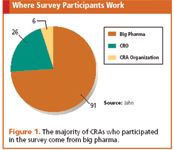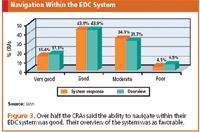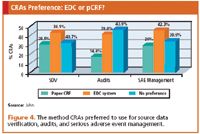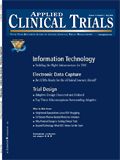CRAs Rate EDC
According to results from a recent survey, clinical research is poised for the eClinical journey ahead.
Today, many businesses routinely capture data electronically for regulatory and business purposes. However, health care providers, regulatory authorities, and the pharmaceutical industry have resisted this industry transforming technology for a long time for various reasons.1 But the availability of electronic health data becomes more and more crucial for the quality of medical care.2

(Photography: Jim Shive)
With respect to research activities, the same trend is seen as companies face increasing pressure to bring new, innovative, and safe drugs to the market faster and in a more cost conscious way. Moreover, increasing concerns over product safety has resulted in the need for more and longer trials and the need to use new electronic systems to make safety information available more quickly.3
In addition, higher and increasing demands regarding data quality and availability are being requested by the regulatory authorities. Electronic safety reporting, electronic clinical trial applications, and electronic submission via the Electronic Common Technical Document (eCTD) are recent examples. Thus, there are several attempts to utilize new technologies toward the vision of eClinical—an integrated electronic infrastructure that links all aspects of R&D, from planning to submission.
But what are the reasons that the majority of clinical trials still do not use EDC as a standard tool?4 Why do the majority of trials still use the traditional paper CRF (pCRF) to collect study data? One of the reasons could be that the systems in use are not yet user friendly and customized enough to allow easy use on site. This would include data entry and monitoring functions. Therefore, the main objective of the survey described in this article was to have a look for practical implications of EDC on site.
In search of practicality
For this purpose, a survey of 123 CRAs was conducted from November to December 2006 in Germany. CRAs were selected to report about their experience with EDC on site because they have to deal with the practical implications of this technology. The use of EDC has a major impact on CRAs' daily work with respect to their duties according to ICH-GCP (e.g., source data verification, safety reporting, auditing, and query handling).
Moreover, CRAs are one of the key drivers for a successful EDC change management process, which can be influenced by their satisfaction rate. Their practical experiences could give valuable information about the main advantages and disadvantages of EDC and how it is perceived in comparison with the traditional paper approach. Therefore, the result of this survey might help us understand why promising new technologies like EDC are still not commonly used in clinical research.
In order to qualify for participation in the survey, the CRA needed to be currently involved in at least one national or international EDC trial conducted in Germany and in charge of at least one clinical trial conducted at a German site using pCRF. The questionnaire mainly focused on the CRA's satisfaction with EDC, potential pitfalls in practice, and possible advantages and disadvantages compared to pCRF. As it can be assumed that most of the CRAs were involved in more than one clinical trial at the time of the survey, they were asked to focus on that trial.
EDC in use
Altogether, 123 CRAs from nine companies in Germany responded to the survey (see Figure 1). The total response rate was approximately 50%. All of the participating pharmaceutical companies were known to routinely use EDC for their trials.

Figure 1.
As most of the CRAs in Germany are young academics, the majority of survey participants were between 25 to 40 years old; one third (33.3%) were between 26 and 35 years; and another slightly smaller group (27.6%) 35 to 40 years old. Regarding their general job experience, more than one third of the survey participants (35.8%) have worked as a CRA for one to three years, 22% for two to four years, and more than 30% for at least seven years. Concerning the specific experience of the survey participants with EDC trials, half of the group (52.8%) had good experience, meaning they were involved in one to three EDC trials, while the second half had considerable expert knowledge, having been involved in more than four EDC trials.
Sites involved included hospitals (52%), general practitioners (33.3%), and specialists (10.6%). A small percentage were site management organizations (1.6%) or other types of sites not specified (2.4%). Looking at their EDC experience, more than 50% of them were "familiar" with this technology. As shown in Figure 2, the systems used were primarily market leaders.

Figure 2.
Main results
The majority of the participants perceived EDC as a valuable tool for their activities on site. They were satisfied with all practical aspects of the technology, such as navigation within the system (e.g., the possibility for cross checks and consistency checks to enable source data verification). Moreover, they preferred the paperless approach for their daily monitoring activities regardless of the system in use (see Figures 3 and 4).

Figure 3.
The vast majority of the CRAs clearly favored the EDC system over traditional pCRF with regard to query resolutions. A majority of the participants (75.6%) stated that query handling was easier with an EDC tool compared to pCRFs. However, the most important advantage of EDC for 87% of the participants was less problems with bad handwriting—a parameter that might have been underestimated—followed by better site status information (63%) and better patient data overview (63%).

Figure 4.
Technical issues such as time needed to solve technical problems (81%), inexperienced site staff (66%), and the need for training (53%) were seen as the main disadvantages. Nevertheless, almost 80% of the CRAs rated their overall satisfaction as "good" or "very good." In their answers to the survey's summary questions, they did say that some improvements could be made regarding the speed of data transmission. However, in today's age of growing information highways and increasing broadband speed, this will probably not be a lasting issue.
CRAs prefer EDC
Looking at the overall results of the survey, one can conclude that sponsors, sites, CRAs, and the EDC systems themselves seem to be ready for the eClinical journey—at least with respect to the practical implications of EDC on site. The results show that the vast majority of the CRAs were satisfied with all practical aspects of the technology. Moreover, they preferred the paperless approach for their daily monitoring activities, and there were no significant practical obstacles beside improving the speed of data transmission. Altogether, EDC systems these days appear to be mature enough to facilitate and support the monitoring on site—one of the most time-consuming and expensive tasks within clinical development.5
The main EDC disadvantages mentioned in the survey, such as the time needed to resolve technical problems, are perhaps the price that has to be paid in order to benefit from the new technology. However, this does not explain why EDC is not used more frequently in clinical trials. There must be other reasons. One possible reason could be that using EDC is not just about using a new technology instead of a pencil; it has a deep impact on clinical research and on how it is conducted in general. It needs a full set of change management activities. However, there is no proof that this is, in fact, the reason why paperless clinical trials are still not more common. This has to be investigated further.
Merger of EDC and EHR
The Electronic Health Record (EHR) is defined as a patient central information resource for clinicians—a "secure, real-time, and point-of-care patient centric information resource for clinicians."6 It should aid in the decision making of physicians by incorporating evidence-based information and by providing access to a complete set of patient health records. It also helps with the collection of data for billing, disease management, and resource planning. The idea to use EDC in health care is not new. Efforts to develop EHRs have been made in many parts of the world for many years,7 and there is still a global trend toward the use information technology in health care.
It is well known that clinical research also can benefit from EHRs. The main advantage of having only one database for normal patient care activities and clinical research is obvious: Data would be entered only once and could then be available for both. The elimination of double data entry on site could improve efficiency enormously. There would be fewer errors from data transcription and the costly and time-consuming process of source data verification could be avoided. Moreover, this would offer the potential for real-time response to possible adverse reactions and could finally speed up the process of clinical trials.8
Reality, indeed, is still different. Most of the existing EHR systems cannot be used directly as a source for clinical research data. There are two main reasons for that: the variability of systems and data documentation, and the fact that most of the EHR systems are not in line with existing clinical research regulations9 (e.g., FDA regulation 21 CFR Part 11). Despite obvious advantages, there is one important prerequisite for the merger of EDC and EHR: standardization. The same "language" has to be used in both systems to enable users to share, review, sort, and analyze the data. Currently, there are two main standard setting bodies in this area: the Clinical Data Interchange Standards Consortium (CDISC)10 for research data standards and Health Level 7 (HL7)11 for health care data.
The main aim of both standard setting organizations is to contribute to an environment where one electronic source can be used for clinical research, medical care, and regulatory authorities, which makes data entry technologies like EDC useless at the end of the day. But how long will it take until EDC in clinical trials becomes unnecessary? According to a December 2006 Applied Clinical Trials online survey,12 70% of total responders (375) agreed or strongly agreed that EDC and EHR will merge within the next five years. This figure shows that more and more clinical trial professionals believe that this scenario will become true soon. This belief in a short-term change in technology has been here before. In the early 1990s, the first steps toward the use of EDC systems were made.
Elke Jahn,* MSc, is group manager, clinical research & medical information, Berlin-Chemie AG, Glienicker Weg 125, 12489 Berlin, Germany, email: ejahn@berlin-chemie.deJohann Pröve, MD, is global head, data management, Bayer Schering Pharma.
*To whom all correspondence should be addressed.
References
1. MarketResearch.com, "How Electronic Data Capture will Change Health Care and Pharmaceutical Marketing," www.marketresearch.com/map/prod/1204213.html (December 2005).
2. M.J. Ball, D.E. Garets, T.J. Handler, "Leveraging IT to Improve Patient Safety Methods," Methods ofInformation in Medicine, 42, 503-509 (2003).
3. J. Rogers, "Today's Technology Makes Significant Improvements in Trial Safety Systems Possible," Applied Clinical Trials, www.actmagazine.com/appliedclinicaltrials (February 2006).
4. D. Iberson-Hurst, "E-Source is Coming: Report of CDISC 2004 Survey (Excluding ePRO Trials)," BIO IT World (July 2005).
5. J.A. Di Masi, R.W. Hansen, H.G. Grabowski, "The Price of Innovation: New Estimates of Drug Development Costs," Journal of Health Economics, 22 (2003).
6. T. Handler et al., Healthcare Information and Management Systems Society, Electronic Health Record Committee, EHR Definition, Attributes, and Essential Requirements Version 1.0 (2003).
7. A. Garfield, Electronic Health Records in Europe: A Shared Vision for Tomorrow, Presented at the Midwest Instruction and Computing Symposium, University of Northern Iowa, Cedar Falls, Iowa, April 5-6, 2002.
8. P. Bleicher, "Integrating EHR with EDC: When Two Worlds Collide," Applied Clinical Trials, www.actmagazine.com/appliedclinicaltrials (March 2006).
9. The eClinical Forum and PhRMA EDC/eSource Taskforce, The Future Vision of Electronic Health Records as eSource for Clinical Research, Version 1.0 (September 2006).
10. Clinical Data Interchange Standard Consortium, www.cdisc.org.
11. Health Level Seven, www.hl7.ca.
12. Clinical Trial News, "EDC & EHR: Readers Optimistic About Future Merger," Applied Clinical Trials, 15 (12), 12 (December 2006).

Improving Relationships and Diversifying the Site Selection Process
April 17th 2025In this episode of the Applied Clinical Trials Podcast, Liz Beatty, co-founder and chief strategy officer, Inato, discusses a number of topics around site engagement including community-based sites, the role of technology in improving site/sponsor relationships, how increased operational costs are impacting the industry, and more.
SCOPE Summit 2025: Enhancing the Patient Experience Through Site Centricity
February 12th 2025In an interview with ACT senior editor Andy Studna at SCOPE Summit, Ashley Davidson, vice president, product lead - sponsor tech strategy, Advarra, highlights the need for more site-centric approaches in study startup.